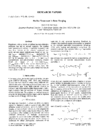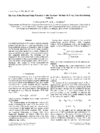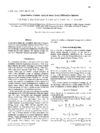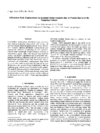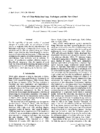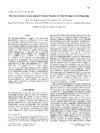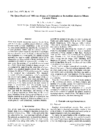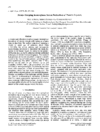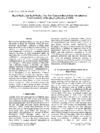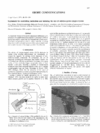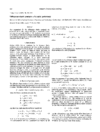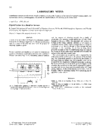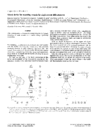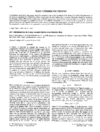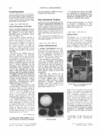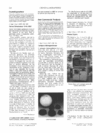issue contents
August 1997 issue

Cover illustration: A crystal of the protein phosphorylase b flash-cooled to 100 K in a 1 mm-diameter mohair loop prior to collection of X-ray diffraction data. Courtesy of Elspeth Garman and Stephen Lee, University of Oxford.
research papers
Routines employed in the SORTAV program for identifying and downweighting mismeasured outliers in merging multiply measured data sets are described.
This study presents a new technique for calculating the mean crystallite size and root-mean-square strain combining the variance method and the fit of the diffraction profiles by a pseudo-Voigt function.
Basic principles of a global evaluation technique for small-angle scattering data of interacting particles are presented.
A method to obtain the orientation distribution function of a polycrystalline material diractly from X-ray diffraction spectra is presented. It uses the maximum-texture-entropy assumption to reduce the diffraction data needed for the quantitative texture analysis.
Analytic calculation and Monte Carlo simulation of peak-shift effects due to the partial burial of the diffracting gage volume are successful in showing the origins of anomalous peak shifts in neutron strain measurements. The Monte Carlo simulation fits experimental measurements of such shifts in a nickel powder sample.
A new Laue technique, recommended for the real-time observation of structural changes of crystals in an environment of heat or an electric or magnetic field, is presented.
The equation of state of quartz has been determined with high precision to a maximum pressure of 8.9 GPa by high-pressure single-crystal diffraction. The new equation of state can be used to determine pressure to a precision of 0.009 GPa at 9 GPa.
A method for quantifying two forms of α-cristobalite in devitrified alumino-silicate fibres is given. The different natures of these two forms of α-cristobalite were examined by X-ray diffraction and differential scanning calorimetry.
A method is described to diffuse rare gases into protein crystals at elevated pressure and to shock-freeze these crystals without loss of the protein-associated rare gas.
Glasses containing Ag(Cl, Br) or Ag needlelike particles are studied by fitting of a two-dimensional model to small-angle X-ray scattering data obtained at the HASYLAB (DESY) synchrotron source.
The calorimetrically and dielectrically observed phase transi- tions close to 675 K in Ba6CoNb9O30 and 590 K in Ba6FeNb9- O30, together with the dielectric hysteresis that each exhibits, verify the structural prediction that the materials are new ferroelectrics.
The work describes a novel application of a recently developed statistical partial least-squares regression technique for the problem of establishing relationships between experimental variables in crystallization trials and the experimental results.
short communications
Application of local temperature control to ΔT-grown single crystals allows tailoring of the size.
New expressions for the diffraction elastic constants are presented for a cubic polycrystal that is statistically homogeneous, isotropic, and disordered.
laboratory notes
A model of an air cooler in a laboratory chamber furnace, for simultaneous regulation of different crystallization rates in a series of test tubes with the purpose of obtaining crystals, is presented.
This work describes a micrometric manipulating device for easy mounting of small crystals on a needle along a preferred orientation.
fast communications
A method is proposed to estimate and correct for the amount of λ/2 contamination inherent in area-detector data. The method has been tested on data obtained with a charge-coupled-device detector using Mo Kα radiation. For routine data sets, the correction is shown to be insignificant.
A generalized spherical harmonic description of the texture for polycrystalline materials has been implemented in a multiple phase/multiple data set Rietveld refinement code and is demonstrated with an example.
crystallographers
Free 

new commercial products
Free 



 journal menu
journal menu









